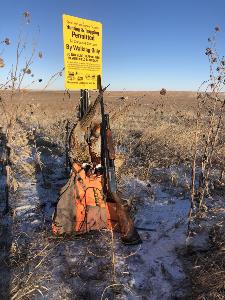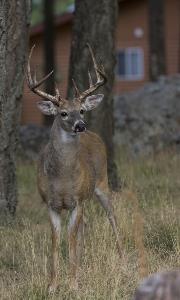The old willow was surrounded by a thicket of goldenrod and aster with an understory of uncropped bluegrass – a tangle I knew was home to several cottontails. In the fall, I’d prowled the edges of this patch in the hope of getting a shot with my bow, but in three months I’d gotten no more than a momentary look at one or another of the residents as they dove into their stronghold.
Now it was January, with most of the leaves gone or flattened under six inches of snow. I climbed up into the tree around four in the afternoon, ready to watch for movement as the gray winter light faded toward evening, an arrow nocked under my mittened hand against the chance that a rabbit might move out before dark. A tree stand for cottontails. I was 13 years old.
My dad was a dyed-in-the-wool hunter, but the hunts we made together stand out in my mind nearly 60 years later because they were rare. He made sure I knew how to point a rifle and shotgun, bought me boots and long johns, and kept a couple of bales of straw in a rack in the backyard so I could practice archery. The Bear Cub recurve I used around home was a cooperative purchase – half out of my allowance and lawn-mowing earnings, half from dad. Same with the arrows and quiver. But when it came to actual field time, I was mostly on my own.
Most of the hunters I know today tell similar stories about their early hunting years. Few of us grew up on farms or ranches, so we prowled the humble patches of “rabbitat” – oak timber at the edge of suburban neighborhoods, often in sight of our own homes and dozens of others. Most of us came from families with a hunting tradition, but the hunters who mentored us were fully occupied with the demands of supporting a household.
They showed us the ropes and took us out two or three times a season. Much of the rest was up to us. It’s a detail that is often overlooked in the modern effort to attract new hunters.
Hunters Needed for Wildlife Management

One of the most important issues in wildlife conservation is how to sustain the tradition of hunting in America. Over the last century or more, hunting has played a crucial role in wildlife management. The hunter’s demand for abundant, widely distributed game has driven the recovery of nearly all game species along with a host of non-game animals. It has protected habitat where it still existed and rebuilt habitat where it had been destroyed. It has provided the backbone of political support for wildlife as well as a healthy portion of the funding for ecological research and on-the-ground conservation.
For all these reasons, wildlife professionals are worried about the ongoing decline in the number of hunters in America. In 1991, the U.S. Fish and Wildlife Service estimated that 14.1 million Americans over the age of 16 hunted. By 2016, that number had dropped to 11.1 million, while at the same time the nation’s population grew by 70 million.
There have been many efforts to reverse this downward trend in hunting. In 1970, the federal government began to provide encouragement and assistance for hunter education programs, and by the late 1970s, nearly every state wildlife agency in the country offered a beginning course. Ducks Unlimited, Pheasants Forever, the National Wild Turkey Federation, and several other private-sector conservation groups launched Saturday morning programs designed to help young people get started in hunting.
In 1991, Christine Thomas of the University of Wisconsin-Stevens Point introduced her “Becoming an Outdoorswoman” program, an educational program tailored to women that has gained national popularity. A decade later, the National Archery in the Schools Program was started in Kentucky and has since been adopted in more than 13,000 schools in 47 states, 8 provinces, and 11 other countries. In an era when firearms have been banned from most schools, archery training offers a way for school kids to get familiar with this basic hunting tool.
In the past decade, streaming video has opened up an entirely new educational avenue for beginning hunters. Hunting techniques, the use of various weapons, field dressing animals, butchering big game, and cooking game meat are all covered (in sometimes daunting detail) online. While these videos occasionally reveal marked differences of opinion among their producers, they are valuable guides to elements of hunting that were once passed from mentor to beginner in the field.
But despite all these efforts, the number of hunters has continued to sag. As we look for ways to reverse the trend, I think it’s worth remembering how most avid hunters got their start. Boiled down to the essentials, they needed a teacher and a place to practice.
A New Approach
Plenty of folks have invested time and money in the teaching effort, but recent analyses of efforts to recruit hunters suggest that we need to take different a approach.
One-day classes don’t encourage many people to join the discipline of hunting. Same goes for once-a-season youth hunts. The same may even apply to classic hunter-education programs that target youngsters between the ages of 10 and 15 – kids who may have the interest but lack guidance, equipment, or transportation.
A new effort to give entire families a start in hunting has also proven ineffective and would be difficult to scale up to a meaningful size even if it did work.
One flaw in our approach may be our exclusive focus on young people. The established dogma that a person has to start hunting before he or she is 12 years old is proving to be outdated. With the rise of the “locavore” move-ment and the growing interest in organic food, more and more young adults are taking up big game hunting. They’re not after trophies – they’re after pure red meat. They have the money to get the equipment they need and the transportation they need to get to the field. All they really need is some help getting started. An adult-oriented hunter education course might help with that. It should certainly stress safety, but it should also answer questions about weaponry, how to find a hunting spot, how to find game, and how to handle meat in the field and in the kitchen.
For some people, a few hours of classroom instruction may not be enough. There is a need for mentors for beginning hunters of all ages. It would be nice if someone took up the chore of connecting potential mentors with those students. There has been some discussion about insurance to indemnify mentors against accidents in the field. In this modern era of hair-trigger litigation, that might also be a useful addition to any mentor program.
But no matter how we improve the way we teach hunting, the instruction will do little good if new hunters have no place to practice what they learn. Access is the crucial problem for hunters across the modern American landscape – not only for beginners but for veterans of the discipline who give up hunting for lack of a place to go.
A Place To Start
Over the last 20 years, many state wildlife agencies have established programs to open private land to hunters. Usually this is land with cover crops paid for by the conservation title of the federal Farm Bill. These access programs have been godsends for active hunters, but they offer little to a beginner who may not know about them or have the transportation to get there.
The tendency of most wildlife agencies, state or federal, is to provide hunting access far from town. This has the advantage of limiting complaints from neighbors and may reduce the number of hunters using the area to a level the habitat and game can withstand. Unfortunately, 13-year-old kids on their bicycles can’t make it to such places on their own, and parents are unlikely to be enthusiastic about driving them there. Even a 60-year-old former hunter with a bad back and aging knees may not be interested in making that drive.
We should think about establishing hunting spots close to town, even within biking distance. Growing deer management problems in cities and suburbs have persuaded many urban dwellers to soften their objections to hunting. We’re victims of our own success in rebuilding populations of white-tailed deer. Large deer populations in urban areas have led to complaints about everything from destruction of landscaping and collisions with cars to the spread of the tick that carries Lyme disease – problems that have led many cities to loosen their restrictions on the use of bows and even muzzleloaders inside city limits.
While there is growing support among urban residents for some kind of deer control, including hunting, access remains a problem. Could state or local entities pay urban and suburban landholders to allow hunting access in much the same way they pay farmers in rural areas? Could managers adapt techniques that are used to attract deer in the country to improve hunter access and success in town? It would be interesting to try.
Urban bowhunting for deer may not be the best way to start a young hunter. Small game hunting is less controversial and less likely to lead to problems with wounded animals. It might be possible to use the change in attitude toward bowhunting to expand hunting opportunities into the arena of small game such as rabbits and squirrels. Wildlife managers know how to produce harvestable surpluses of small game but have never really tried near urban areas.
The demands placed on near-urban hunting grounds could become more than the area could handle. If that were the case, it might be necessary to restrict access to people too young to drive. If demand were still too great, it would be a sign that we need to provide more such areas.
Urban waterfowl could provide another opportunity for beginning hunters. Since firearms would be involved, such hunting would have to be more carefully regulated. I once worked on a shooting preserve that offered flighted mallards to its customers. The blinds in that operation were designed to stop anyone from shooting outside a narrow flight path. If a mentor were in such a blind with one or two beginners, it would be fairly easy to keep the shooting safe. And if the blind were only 10 minutes from town (instead of 2 hours away), it would be easier to get mentors there as well as students. Parents could drop young hunters off at 6:30am and pick them up at 9:00am for a soccer game.
Waterfowl managers know how to attract resident mallards and Canada geese. I wonder if it’s possible to apply that knowledge to build wetlands that have year-round value as habitat and also provide safe training grounds for young hunters in the fall.

These proposals may not be practical, but we won’t know until we try them. Pilot programs could help identify the approaches that have merit and mill the rough edges off so they mesh with local attitudes toward wildlife and hunters. Near-urban hunting could be controversial in some communities. (After nearly 40 years with two state wildlife agencies, I understand that.) But hunting remains one of the most cost-effective ways to manage game populations and the problems they may cause in town. It also offers young people a taste of independence — the opportunity to test their skill, patience, knowledge, and endurance without an adult hovering in the background.
There is a purity to hunting straight out the back door, like a fox setting out from its den.Coming home as the light fades, cold and leg-weary, with stories of the wild doings out behind the house that no one else has taken the time to see. It’s an experience that stays with hunters all the rest of their lives.
With a little thought, I think we could provide places for such things to happen.
Support hunter recruitment